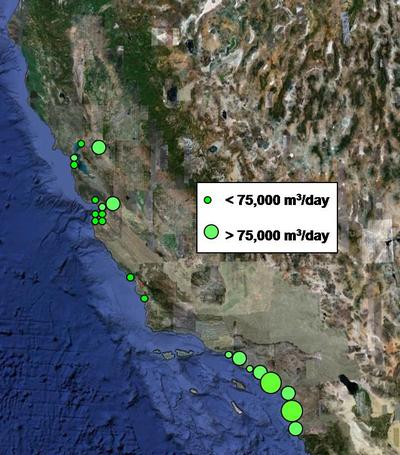 Research Areas > Contaminants > Brine Discharge Panel
Research Areas > Contaminants > Brine Discharge Panel
Project: Expert Panel on Fate and Effects of Brine Discharge
Background and Objectives
In the face of growing water needs in California, resource management measures like seawater desalination, wastewater reclamation, and ground water treatment are rapidly expanding to help augment water supplies. These activities typically produce a brine waste discharge that consists of concentrated salts and other compounds that remain after water is purified. The properties of brine can cause discharge plumes into the ocean to behave differently than traditional wastewater, stormwater, and power plant cooling water plumes. Typically, brine is discharged into marine waters from deep diffusers. In some cases, it is released across the beach or through riprap into shallow ocean waters. If the density of brine plumes exceeds the density of ambient seawater, the plume could settle on the ocean floor and expose marine life to potentially stressful levels of salinity or other constituents.

Twenty-one coastal desalination plants are either proposed or in operation in California, shown by the amount of discharge volume (image courtesy of Dr. Carol Reeb)
The State Water Resources Control Board (SWRCB) is developing a policy to protect coastal waters from the potential adverse impacts of brine discharges for the California Ocean Plan. To assess current scientific knowledge and inform the SWRCB’s policy development, SCCWRP convened a panel of experts to address the following questions related to brine discharge:
-
How can the effects of discharges be minimized through proper disposal strategies?
-
What models should be applied to predict how brine plumes will behave?
-
Can cumulative water quality effects associated with multiple brine plumes be evaluated with models?
-
What are appropriate monitoring strategies for these discharges?
Status
This project was initiated in 2011 and completed in 2012.
Methods
First, a panel of experts in the fields of oceanography, plume modeling, ecotoxicology, and marine ecology was selected. The panel met several times over the course of the project to develop recommendations for the SWRCB. A public meeting was held in December 2011 inviting stakeholders to brief the panel on recent scientific findings relative to brine discharge in California, regulatory issues, and other areas of concern. The panel completed its final report in June 2012.
Activity Summary
Date
| Event | Related Materials |
| July 5, 2011 | Project overview meeting |
Presentations:
Summary of Background Material
|
| December 8-9, 2011 | Public comment and review meeting |
|
| June 7, 2012 | Final report released |
|
Findings
The panel's review found, if properly executed, brine can be disposed of with minimal environmental effects. Desirable discharge methods include co-disposal with heated cooling water from power plants or domestic wastewater, or from a multiport diffuser if “pure” brine is released. Discharges with rapid initial dilution of at least 20:1 should not produce adverse impacts beyond a few tens of meters from the discharge. Modifications to the State's Ocean Plan are needed to establish effluent objectives and plume dilution modeling approaches to address the fate of negatively buoyant brine discharges. Because of uncertainties in plume modeling and predicting the biological effects of the discharges, a field monitoring program should be used to study conditions before and after brine discharge is initiated.
Partners
This project was conducted in collaboration with the State Water Resources Control Board.
Panel Members:
This page was last updated on: 8/13/2012